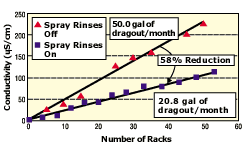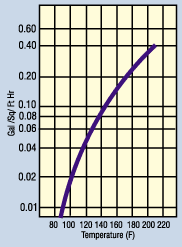Reducing Dragout with Spray Rinses
Installing spray rinses on plating lines can reduce dragout and improve rinsing performance...
Using spray nozzles as part of a rinse system can significantly reduce dragout of expensive and hazardous process chemicals and the amount of rinse water needed. When used on parts over plating and dragout tanks, spray rinses provide a method to recover concentrated process chemicals for reuse. By reducing dragout, spray rinses allow immersiontype rinse tanks to operate at lower flow rates or even as static rinses. Also, spray rinses use rinse water more efficiently than stagnant and running rinses. Spray rinse applications in plating lines (both handoperated and automatic conveyor and hoist systems) include use over plating tanks, dragout tanks and rinse tanks. The ideal spray rinse application permits dragout reduction and reuse and improves rinse performance.
Nozzles are the key components of spray rinses and are commercially available with a wide range of flow rates and several spray patterns. Common suppliers of nozzles are manufacturers of industrial nozzles and suppliers of plumbing and irrigation equipment. For applications over plating and dragout tanks where minimizing flow rate is critical, nozzles with flow rates from 0.04-1.0 gpm are used in groups to provide coverage and are operated intermittently to minimize water use. Nozzles with flow rates from 1.0-10 gpm are typically used for applications where minimizing flow rate is not so critical. The two types of nozzles available are hydraulic nozzles, which spray water only, and airatomized nozzles, which use both water and air. Available nozzle spray patterns include full cone, hollow cone, flat fan and fine spray, such as mists and fogs. Hydraulic spray rinses with full cone, flat fan and fine spray patterns are adequate for most applications on plating lines. Air-atomized nozzles can be used where compressed air is available to increase the rinsing effectiveness of the spray by generating a mist or fog. Other nozzle specifications important to designing spray rinses are the angle and length of the spray pattern, which determine the number and spacing of the nozzles. Specifying a nozzle spray angle can help to achieve complete coverage or overlapping patterns from adjacent nozzles.
Components for spray rinses include filters, switches (electrical or mechanical) to turn the nozzles on and off and check valves. Rust and dirt particles from aging metal supply lines can prevent check valves from opening and sealing properly and can cause nozzle spray patterns to deteriorate. Adding a filter to the water supply line is necessary to prevent clogging of the small orifices in check valves and nozzles. Switches (operated manually or with timers) can be used to shut off flow when spray rinses are not needed. Using switches ensures that the resulting rinse solution is low in volume, highly concentrated and easier to return to the plating tank. In spray rinses with nozzles that operate intermittently or on a timer, check valves offer two advan-tages: they prevent water in the supply line from draining into the tank when the switch closes; and they maintain line pressure so that the spray pattern develops quickly when the water is turned on. These advantages are significant for spray rinses installed over plat-ing tanks and for stagnant rinse tanks where overflow is a possibility.
The Merit Partnership sponsored a P2 project that involved installing and evaluating spray rinses at All American Manufacturing, Los Angeles, CA. The All American facility performs job shop and captive shop work, including both metal stamping and forming operations, and it electroplates decorative nickel and chrome onto plumbing fixtures. The facility covers about 20,000 sq ft, of which 5,000 sq ft is dedicated to finishing. All American employs about 10 workers in the electroplating department for one shift per day. The plating line consists of two parallel nickel plating lines with an automated hoist followed by a single chrome plating line that is first hand and then conveyoroperated. The rinse system for each line originally consisted of an immersiontype dragout tank and a series of stagnant and running rinse tanks. The primary objective of the P2 project for All American was to reduce dragout loss and enhance dragout recovery by adding several spray rinses to the existing rinse systems. By first reducing dragout, All American could reduce water use and consider chemical recovery technologies that would move the operation toward its goal of zero discharge.
Three spray rinses were installed at the facility: one over a pair of nickel plating tanks, one over a pair of empty nickel dragout tanks and one over the chrome plating tank. Nozzle material was selected based on the corrosiveness of each installation. An adjustable check valve was installed immediately upstream of each nozzle to prevent draining of water and to maintain line pressure. The net flow rate from the spray rinses over the nickel plating tanks was selected so as not to exceed the evaporation rate of the tanks and to minimize evaporator use before dragout was returned to the plating tanks. (see sidebar)
Both spray rinses on the nickel plating lines are actuated by switches tripped by the upanddown movement of the hoist. Each tank has eight nozzles mounted around the lip of the tank and directed slightly downward so that the combined dragout and rinse water drop into the tanks and overspray is minimized. The spray rinses on each tank turn on separately once per cycle. The spray rinses over the plating tanks turn on as the racks are withdrawn from the tanks, and the spray rinse over the nickel dragout tanks turns on as the racks are lowered into the tanks.
Six fine spray misting nozzles were installed above a hang bar over the chrome plating tank. One nozzle is used for each rack position on the hang bar. A compressed air vibrator is also attached to the hang bar in order to enhance droplet formation. The nozzles are angled about 45 degrees toward the splash guard at the rear of the tank. The nozzles are actuated by two pressuresensitive contact switches installed along the top of the hang bar. Each switch controls three nozzles and is actuated by the weight of the racks on the hang bar.
Maintenance of the spray rinses includes periodically removing the nozzles from the nozzle bodies and washing away any obstructions from the nozzle interiors with water or compressed air. The filters used at All American are canister-type filters with no filter elements and need to be periodically unscrewed and rinsed. Before the filters were installed, many of the check valves became clogged and did not open and shut quickly and completely. With the filters in place, these problems have not recurred.
The total cost for all three spray rinse applications was $4,890. Installation of the spray rinses was performed by All American staff, and operation and maintenance are performed as part of the staff’s daily inspection routine.
Nozzle costs vary widely (from $2-70 per nozzle) depending on the material used and the supplier. Generally, industrial spray nozzle manufacturers provide higher quality at a higher cost and offer nozzles made of a variety of materials with precise spray patterns and flow rates. Plumbing and irrigation equipment suppliers provide less expensive, plastic nozzles and less selection of nozzle operating parameters.
After installation of the spray rinses and several weeks of system shakedown and fine tuning, a series of tests were per-formed under controlled plating and production conditions with and without the three spray rinses operating. As parts were plated, the conductivity (which can be related to the concentration of plating solution) of the rinse water was measured in a stagnant rinse tank immediately following the tanks with spray rinses.
During the tests, the spray rinses over the nickel plating and dragout tanks together reduced dragout from the nickel plating lines by 58% compared to dragout from the lines operating with no spray rinses (see Figure 1). The spray rinse over the chrome plating tank reduced dragout by 64% compared to the system operating with no spray rinse.
Data from the tests demonstrate that the addition of the spray rinses to the existing rinsing scheme at All American dramatically reduced the dragout from both the nickel and chrome plating lines (see Figure 2). Based on the savings associated with recovery and reuse of the nickel and chrome plat-ing solutions and the corresponding rinse water reduction possible, the payback period for the rinses installed is 0.6 year. Although All American does not treat its wastewater before discharge, facilities performing onsite treatment would experience additional savings of the treatment chemical, sludge disposal and operating costs associated with treatment systems. Industry average costs for treatment of wastewater from electroplating operations are about $12 per 1,000 gal.
Read Next
Episode 45: An Interview with Chandler Mancuso, MacDermid Envio Solutions
Chandler Mancuso, technical director with MacDermid Envio discusses updating your wastewater treatment system and implementing materials recycling solutions to increase efficiencies, control costs and reduce environmental impact.
Read MoreA ‘Clean’ Agenda Offers Unique Presentations in Chicago
The 2024 Parts Cleaning Conference, co-located with the International Manufacturing Technology Show, includes presentations by several speakers who are new to the conference and topics that have not been covered in past editions of this event.
Read MoreEducation Bringing Cleaning to Machining
Debuting new speakers and cleaning technology content during this half-day workshop co-located with IMTS 2024.
Read More



















.jpg;maxWidth=300;quality=90)



